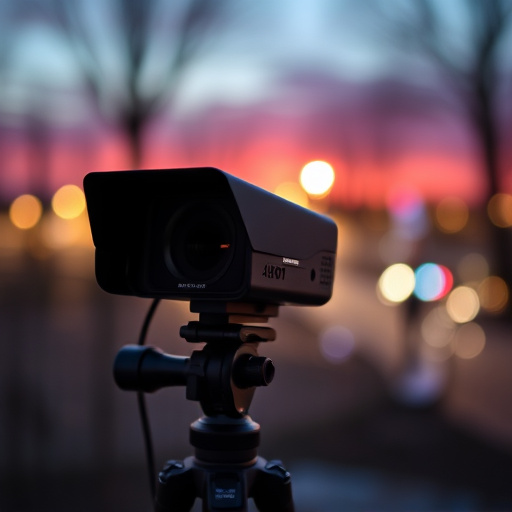Mini spy cameras present unique challenges during nighttime recording due to glint detection, where miniature lenses reflect light, causing glare and revealing positions in low-light. Evolving from manual observation to AI-driven methods, glint detection now uses machine learning models trained on extensive datasets for real-time analysis, enhancing efficiency and reliability. Solutions include tailored IR filters, strategic camera positioning, and lens angle adjustments, ensuring clearer images and minimizing false alarms. Future advancements promise improved image stabilization, higher resolutions, and more accurate glint detection, revolutionizing nighttime surveillance with mini spy cameras.
In the realm of surveillance, Mini Spy Cameras have become increasingly popular for nighttime recording. However, these tiny devices often face a significant challenge: glint detection in low-light conditions. This article explores the intricacies of understanding and overcoming this obstacle. From simple to advanced detection techniques, we delve into solutions that ensure glint-free recordings. Furthermore, it examines future prospects, highlighting innovations that are revolutionizing night vision surveillance technology for enhanced security.
- Understanding Nighttime Glint: The Challenge of Mini Spy Cameras
- Detection Techniques: From Simple to Advanced Methods
- Implementing Effective Solutions for Glint-Free Night Recording
- Future Prospects: Enhancing Night Vision Surveillance Technology
Understanding Nighttime Glint: The Challenge of Mini Spy Cameras
Nighttime recording with mini spy cameras presents a unique challenge due to their small size and limited optical capabilities. These tiny devices, often used for covert surveillance, are designed to be nearly invisible, making them popular choices for discreet monitoring. However, this very feature also contributes to a significant issue: glint detection. The miniature lenses of these cameras can reflect light from surrounding sources, creating unwanted glare or even revealing the camera’s position in low-light conditions. This phenomenon is particularly problematic when attempting to capture clear images or videos in the dark, as it can obscure details and compromise the overall quality of the recording.
The challenge lies in balancing the need for high-resolution footage with the potential distractions caused by lens glint. Standard image processing techniques may not be effective against these subtle reflections, as they often appear as faint, scattered light rather than distinct noise patterns. Therefore, specialized methods are required to accurately identify and mitigate glint in nighttime recordings from mini spy cameras, ensuring that the captured content remains sharp, clear, and free from unwanted artifacts.
Detection Techniques: From Simple to Advanced Methods
Detection techniques for glints in mini spy cameras during nighttime recordings have evolved from simple to advanced methods over the years. Initially, human observation was the primary tool—a vigilant eye scanning each frame for sudden flashes or reflections. This approach, while labor-intensive, relied on the observer’s acuity and sustained focus.
Advanced methods now leverage computer vision and artificial intelligence algorithms. These techniques employ sophisticated image processing algorithms to analyze video feeds in real time, automatically identifying and flagging glints. Some advanced systems use machine learning models trained on vast datasets of known glint patterns from mini spy cameras, enabling them to distinguish glints from other reflections or noise with impressive accuracy. This shift has not only increased the efficiency of glint detection but also improved its reliability, making nighttime recordings more robust and secure.
Implementing Effective Solutions for Glint-Free Night Recording
Implementing effective solutions for glint-free nighttime recording is crucial when utilizing mini spy cameras in low-light conditions. One proven method involves employing specialized infrared (IR) filters and sensors tailored for night vision. These advanced components minimize the reflection of ambient light, enabling clearer and more detailed images during darkness. By integrating IR technology, mini spy cameras can capture footage with enhanced visibility, making it ideal for security and surveillance applications that demand discreet operation in the dark.
Additionally, careful camera positioning and lens angle adjustments play a significant role. Strategically placing the device to avoid direct exposure to bright lights or reflective surfaces can substantially reduce glints. Adjusting the lens angle slightly away from potential light sources helps in minimizing reflections, ensuring that the recorded video maintains its integrity without unwanted artifacts. These simple yet effective techniques empower users of mini spy cameras to achieve superior nighttime recording quality, making them indispensable tools for various professional and personal monitoring needs.
Future Prospects: Enhancing Night Vision Surveillance Technology
The future of night vision surveillance technology looks promising, with advancements in mini spy camera capabilities playing a pivotal role. As technology continues to evolve, miniature cameras designed for nighttime recording will become increasingly sophisticated. Expect improved image stabilization and higher resolution, enabling clearer visuals in low-light conditions. These developments will enhance the effectiveness of security systems, making it easier to capture and identify subjects even under challenging lighting.
Additionally, the integration of advanced processing algorithms could lead to more accurate glint detection techniques. By analyzing subtle light reflections, these cameras can automatically adjust settings for optimal night-time recording, further reducing false alarms. With ongoing research and development, mini spy cameras are poised to revolutionize nighttime surveillance, offering enhanced privacy and security for individuals and organizations alike.
The detection and mitigation of glint from mini spy cameras in nighttime recording have evolved significantly, driven by the need for clearer and more reliable surveillance. From simple reflection techniques to advanced computer vision algorithms, current methods offer effective solutions. As technology advances, future prospects look promising with enhanced night vision capabilities, potentially revolutionizing the field of surveillance, ensuring sharper images, and better insights in low-light conditions.
